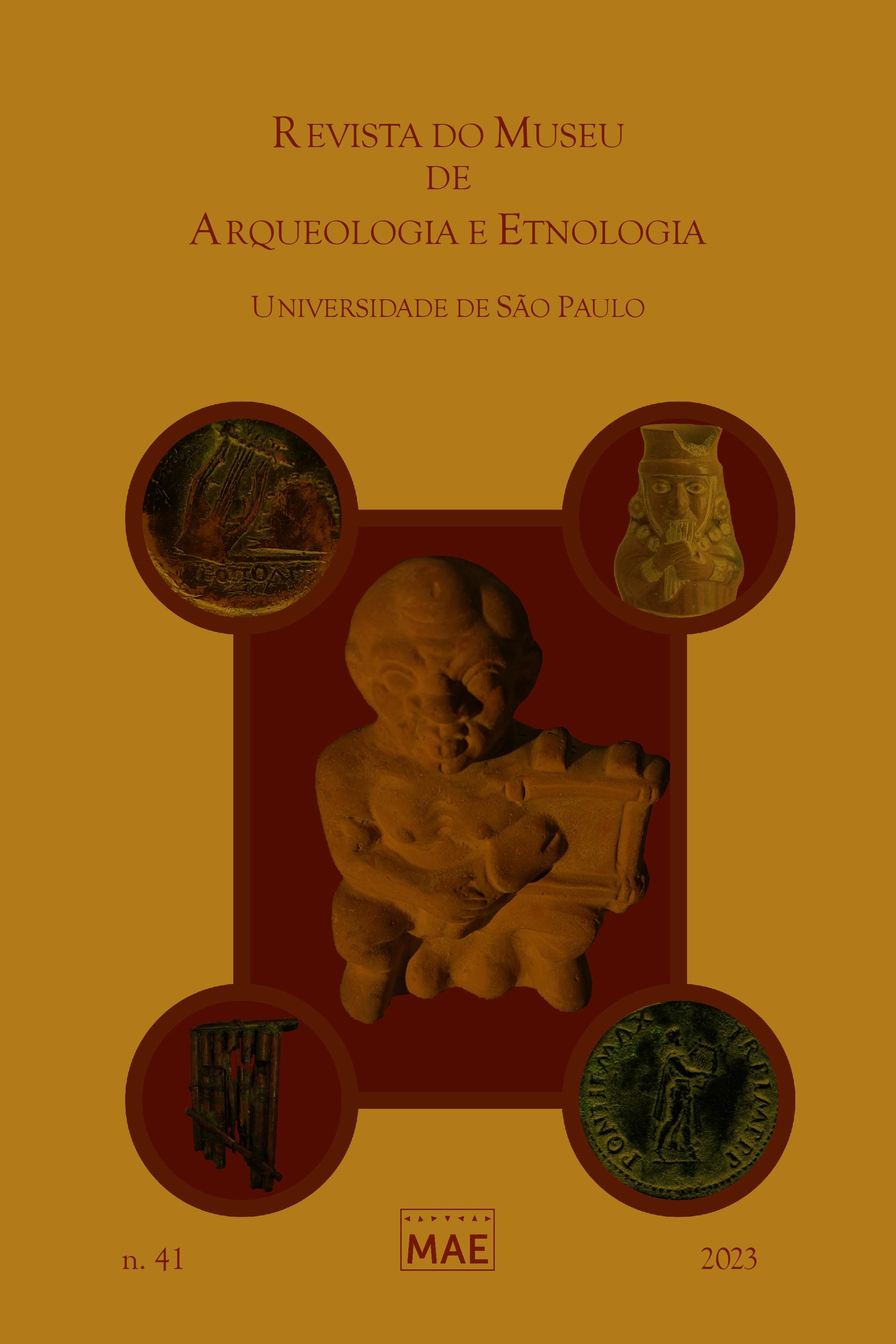Lécito de Xenophantos e a percepção grega da cinegética aquemênida
DOI:
https://doi.org/10.11606/issn.2448-1750.revmae.2023.194561Palavras-chave:
Xenophantos, alteridade, arte grega, arte persa, lécitoResumo
O objetivo deste artigo é investigar a iconografia do assim chamado Lécito de Xenophantos, com particular atenção à forma como a caçada entre os aquemênidas é representada no artefato. Será argumentado que Xenophantos demonstra conhecimento a respeito das práticas venatórias persas, ao mesmo tempo em que, como um artista ateniense, cria um discurso de alteridade sobre tais práticas. Por fim, o lécito será cotejado com diversos sarcófagos persas de forma a demonstrar como a materialidade do artefato possui relação umbilical com sua iconografia.
Downloads
Referências
Arrian. 1976. Anabasis of Alexander:books 1-4. Tradução dePeter. A. Brunt. Harvard University Press, Cambridge, vol. 1.
Barringer, J. 2001. The hunt in the ancient Greece. The John Hopkins University Press, Baltimore, London. Bíblia de Jerusalém. 2020. Paulus, São Paulo.
Boardman, J. 1989. Athenian red figure vases: the classical period. Thames and Hudson, London.
Bolmarcich, S.;Muskett, G. 2017. Artists’ signatures on archaic Greek vases from Athens. In: Seaman, K; Schultz, P (eds.), Artists and artistic production in ancient Greece. Cambridge University Press, Cambridge,154-176.
Briant, P. 1988. Le nomadisme du Grand Roi. Iranica Antiqua 23:253-273.
Briant, P. 2002. From Cyrus to Alexander: a history of the Persian empire. Tradução de Peter Daniels. Eisenbrauns Press, Winona Lake.
Chambry, P. 1954. Notice sur le Traitê de la chasse. In: Xénophon,Anabase-economique.Garnier, Paris, 383-388.
Cohen, A. 2010. Art in the era of Alexander the Great: paradigms of manhood and their cultural traditions. Cambridge University Press, Cambridge.
Delebecque, E. 1973. Le commandant de la cavalerie. Les Belles Lettres, Paris.
Demargne, P. 1973.Le décor des sarcophages de Xanthos: réalités, mythes, symboles. Comptes rendus des séances de l'Académie des Inscriptions et Belles-Lettres2:262-269.
Demargne, P. 1974. Xanthos et les problèmes de l'hellénisation au temps de la Grèce classique. Comptes rendus des séances de l'Académie des Inscriptions et Belles-Lettres 4:584-590.
Diodorus Siculus.1954. Library of History:books 14-15.19. Tradução de C. H. Oldfather. Harvard University Press, Cambridge, vol. 6.
D’Onofrio, A.M. 2018.La metafora della caccia nel fregio della Tomba II del Grande Tumulo di Vergina: dalla hybris dei persiani alla andragathia dei re macedoni. Ostraka:RivistadiAntichità27:35-48.
Ésquilo. 2013. Os persas. Tradução de Trajano Vieira. Editora da Unicamp, Campinas.
Foucault, M. 1981. As palavras e as coisas. Tradução de Salma TannusMuchail. Martins Fontes, São Paulo.
Fox, R.L. 1996. Ancient hunting: from Homer to Polybios. In: Shipley, G.; Salmon, J. (eds.),Human landscapes in classical antiquity: environment and culture. Routledge, London,119-153.
Francisco, G.S.; Sarian, H.; Cerqueira, F.V. 2019. Retomando a arqueologia da imagem: entre iconografia clássica e cultura material. Revista Brasileira de História40(84): 141-165.
Franks, H. 2009. Hunting the eschata: an imagined Persian empire on the Lekythos of Xenophantos. Hesperia78(4): 455-480.
Franks, H. 2012. Hunters, heroes, kings: the frieze of Tomb II at Vergina. American School of Classical Studies, Rome.
García Sanchéz, M.;Vivero, M.A. 2014. Diademas, tiaras y coronas de la antígua Persia: formas de representación y de adopción en el mundo clásico. In:Giner, C.A.;Ortiz García, J.; Peset, M.A. (orgs.),Tiarae, diadems and headdresses in the Ancient Mediterranean cultures. Sema, Valencia, 79-94.
Gex, K. 2014. Athens and the funerary lekythos. In: Manakidou, E.;Valavanis, P. (eds.),εγραφσενκαιεποιεσεν:essays in Greek pottery and iconography in honour of Professor Michalis Tiverios. University Studio Press, Thessaloniki, 321-329.
Goldman, B. 1993. Darius III, theAlexander Mosaic, and theTiara Ortho.Mesopotamia28:51-69.
Hatoum, M. 2000.Dois irmãos. Companhia das Letras, São Paulo.
Herodotus. 1920. The Persian wars: books 1-2. Tradução de A. D. Godley. Harvard University Press, Cambridge, vol. 1.
Herodotus.1921. The Persian wars: books 3-4. Tradução de A. D. Godley. Harvard University Press, Cambridge, vol. 2.
Herodotus. 1922. The Persian wars:books 5-7. Tradução de A. D. Godley. Harvard University Press, Cambridge, vol. 3.
Lezzi-Hafter, A. 2008. Clay, gold, and craft: special techniques in three vases by the eretria painter and their apotheosis in Xenophantos. In: Lapatin, K. (org.),Papers on special techniques in Athenian vases. proceedings of a symposium held in connection with the exhibition “The colors of clay: special techniques in Athenian vases” at the Getty Villa. Getty, Los Angeles, 173-186.
Lezzi-Hafter, A. 2009. The Xenophantoschousfrom Kerch with cypriot themes. In: Annals of the 2ndEnbom Workshop,2009,Kopenhagen.
Llewellyn-Jones, L. 2012. Great kings of the fourth century and the Greek memory of the Persian past. In: Marincola, J.; Llewellyn-Jones, L.; MacIver, C.(eds.),Greek notions of the past in the archaic and classical eras: history without historians. Edinburgh University Press, Edinburgh, 317-346.
Llewellyn-Jones, L. 2016.An orgy of Oriental dissipation? Some thoughts on the ‘camel lekythos’. The Digital Archive of Brief notes & Iran Review (DABIR)1(2):31-38.
Llewellyn-Jones, L. 2017.Persianisms: the Achaemenid court in Greek art, 380-330 BCE. Iranian Studies50: 1-22.
Miller, M. 1995. Persians: the Oriental other. Notes in the History of Art15(1): 39-44.
Miller, M. 1997. Athens and Persia in the fifth century B.C.: a study in cultural receptivity. Cambridge University Press, Cambridge.
Miller, M. 2003. Art, myth and reality: Xenophantos’ lekythos re-examined. In: Caspo, Eric; Miller, M. (eds.),Poetry, theory, praxis: the social life of myth, word and image in Ancient Greece. Oxford University Press, Oxford, 19-47.
Miller, M. 2006. Persians in the Greek imagination. Mediterranean Archaeology19/20: 109-123.
Miller, M. 2017. Quoting ‘Persian’ in Athens. In: Strooman, R.;Versluys, M. (eds.),Persianism in antiquity. Franz Steiner Verlag, Stuttgart, 50-67.
Palagia, O. 2000. Hephaestion’s pyre and the royal hunt for Alexander”. In: Bosworth, A.B.;Baynham, E. (orgs.),Alexander the Great in fact and fiction. Oxford University Press, Oxford,167-206.
Pasinli, A. 1989.Istanbul archaeological museums. A Turizm Yayinlari, Istanbul.
Pliny.1938. Natural history: books 1-2. Tradução de Rackham. Harvard University Press, Cambridge, vol. 1.
Plutarch. 1917. Lives:Agesilaus and Pompey, Pelopidas and Marcellus. Tradução de Bernadotte. Harvard University Press, Cambridge, vol. 5.
Robertson, M. 1992. The art of vase-painting in classical Athens. Cambridge University Press, Cambridge.
Hino homérico a Apolo. 2004. Tradução de Luiz Alberto Machado Cabral. Editora da Unicamp, Campinas.
Sarian, H. 1993. Poieîn-gráphein: o estatuto social do artesão-artista de vasos áticos. Revista do MAE3: 112-115.
Schmitt, P.;Schnapp, A. 1982. Image et société en Grèce Ancienne: les representations de la chasse et du banquet. Revue Archéologique1: 57-74.
Sevinç, N. et al. 2001. A new painted Graeco-Persian sarcophagus from Qan. Studia Troica11: 383-420.
Skrzhinskaya, M. 2000. Xenophantos, an artisan of Athens. Ancient Civilizations from Scythia to Siberia6(3-4): 281-295.
Spawforth, A. 2012.The pamphleteer Ephippus, king Alexander and the Persian royal hunt. Histos6: 169-213.
Strabo. 1917. Geography: books 1-2. Tradução de Horace Leonard Jones. Harvard University Press, Cambridge, vol. 1.
Tripodi, B. 1991. Il fregio della caccia della II tomba reale di Vergina e le cacce funerarie d’Oriente. Dialogues d’Histoire Ancienne(17): 143-209.
Tiverios, M. 1997. Die von Xenophantos athenaios signierte grosse Lekythos aus Pantikapaion: alte funde neu betrachtet. In: Oakley, J.H.; Coulson, W.D.E.; Palagia, O.(eds.),Athenian potters and painters. Oxbow Monographs, Oxford,269-284.
Tripodi, B. 2000. Cacciatori e prede nell“Anabasi”di Senofonte (cacce d’Arabia). AnnalidellaScuolaNormaleSuperiore di Pisa 5(1): 149-158.
Tuplin, C. 2007. Treacherous hearts and upright tiaras: the Achaemenid king’s head-dress. In: Tuplin, C. (ed.),Persian responses: political and cultural interaction with(in) the Achaemenid empire. The Classical Press of Wales, Swansea, 67-97.
Vlassopoulos, K. 2012. The barbarian repertoire in Greek culture. Αριάδνη18: 53-88.
Vlassopoulos, K. 2013. Greeks and barbarians. Cambridge University Press, Cambridge.
Xenophon.1914. Cyropaedia: books 5-8.Tradução deWalter Miller. Harvard University Press, Cambridge, vol. 2.
Xenophon.1925. Scripta minora: Hiero,agesilaus, constitution of the Lacedaemonians, ways and means, cavalry commander, art of horsemanship, on hunting, constitution of the Athenians. Tradução de E. C. Marchant;G. W. Bowersock. Harvard University Press, Cambridge.
Xenophon.1998. Anabasis. Tradução de Carleton L. Brownson.Harvard University Press, Cambridge.
Downloads
Publicado
Edição
Seção
Licença
Copyright (c) 2023 Thiago Biazotto

Este trabalho está licenciado sob uma licença Creative Commons Attribution-NonCommercial-NoDerivatives 4.0 International License.
Dados de financiamento
-
Conselho Nacional de Desenvolvimento Científico e Tecnológico
Números do Financiamento 141445/2019-0


















